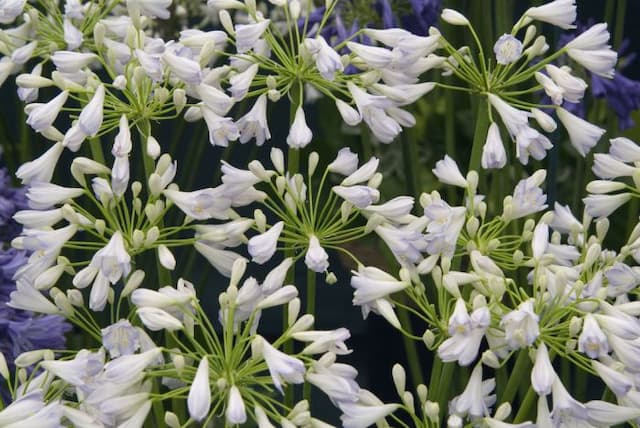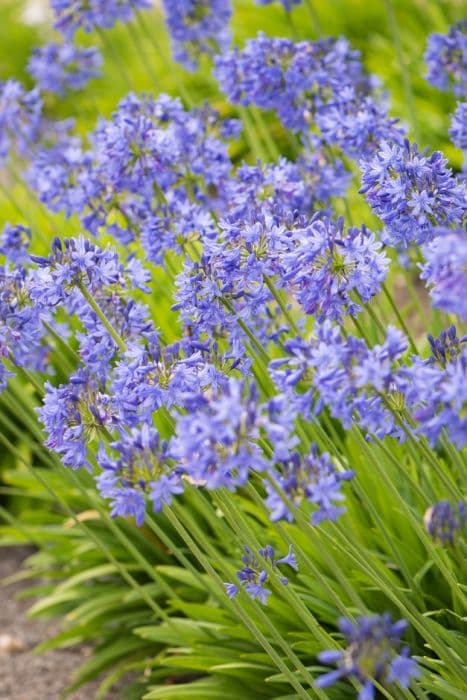Lily of the Nile Agapanthus 'Duivenbrugge Blue'

ABOUT
The Agapanthus 'Duivenbrugge Blue', commonly known as the African Lily, is a striking and elegant perennial plant that is prized for its vibrant floral display. The plant features lush, strap-like green leaves that create a dense clump, resembling a lush grassy tuft. These leaves form a beautiful backdrop for the plant's most arresting feature: its flowers. The African Lily produces tall, upright stems that tower above the foliage. Each stem is topped with a large, rounded cluster of flowers, known as an umbel, which is reminiscent of an exploding firework. The flowers themselves are trumpet-shaped, with a bold and deep blue hue that can add an eye-catching splash of color to any garden. The rich blue petals are slightly recurved at the tips, enhancing the ornamental quality of the bloom. These flower clusters are quite large and dense, containing numerous individual blossoms that come together to create a showy globe of color. The blossoms of the African Lily attract both visual admiration and pollinators such as bees and butterflies to the garden. The overall effect of the plant is one of regal elegance and sophisticated beauty, with the luxurious blue flowers creating a stunning contrast against the background of green foliage.
About this plant
 Names
NamesFamily
Amaryllidaceae.
Synonyms
African Lily, Lily of the Nile, Love Flower.
Common names
Agapanthus 'Duivenbrugge Blue'.
 Toxicity
ToxicityTo humans
The Agapanthus, commonly known as Lily of the Nile, is not highly toxic to humans; however, it can cause mild irritation. If parts of the plant, such as leaves or sap, are ingested, they may cause nausea, vomiting, and diarrhea. Contact with the sap may also result in skin irritation or allergic reactions in sensitive individuals.
To pets
The Lily of the Nile is toxic to pets, such as dogs and cats. If ingested, it can cause gastrointestinal symptoms including nausea, vomiting, and diarrhea. In some cases, more severe reactions such as tremors or an increase in heart rate may occur. It’s important to keep this plant out of reach of pets and to seek veterinary care if any part of the plant is ingested.
 Characteristics
CharacteristicsLife cycle
Perennials
Foliage type
Evergreen
Color of leaves
Green
Flower color
Blue
Height
2 feet [60 cm]
Spread
2 feet [60 cm]
Plant type
Bulb
Hardiness zones
8
Native area
South Africa
Benefits
 General Benefits
General Benefits- Ornamental Appeal: Agapanthus 'Duivenbrugge Blue', commonly known as Lily of the Nile or African Lily, has striking blue flowers that enhance garden aesthetics.
- Low Maintenance: Once established, it requires minimal care, making it suitable for gardeners of all skill levels.
- Drought Tolerance: It can withstand periods of low water availability, fitting well in xeriscaping.
- Attracts Pollinators: The blossoms attract bees and butterflies, promoting pollination in the garden.
- Long Blooming Period: It has a long flowering season, providing color and interest throughout the summer months.
- Versatility: It can be used in borders, pots, or as a cut flower in arrangements.
- Deer Resistance: The plant is typically resistant to deer, reducing the need for protective measures.
- Disease and Pest Resistance: It is generally resistant to many diseases and pests, lowering the need for chemical treatments.
 Medical Properties
Medical PropertiesThis plant is not used for medical purposes.
 Air-purifying Qualities
Air-purifying QualitiesThis plant is not specifically known for air purifying qualities.
 Other Uses
Other Uses- Agapanthus, often known as African lily, can be used in floral art, specifically for creating large and dramatic floral displays due to its tall flower stalks and bold blue blooms.
- In photography, African lily provides a striking subject for close-up photos because of its intricate flower structure and vibrant color.
- The African lily serves as an excellent addition to butterfly gardens as its nectar-rich flowers attract various species of butterflies and beneficial pollinators.
- These plants can be utilized in educational settings for botany studies, particularly in understanding monocot plant characteristics and flower anatomy.
- African lilies can be used as a natural dye source, where the petals provide shades of blue and purple for textiles or crafts.
- This plant is commonly used in the landscaping of traffic islands and public spaces due to its clumping nature and low maintenance requirements.
- The sturdy leaves of African lily can be used for creative crafts, such as imprinting their patterns in clay or plaster for decorative tiles or artwork.
- In culinary presentations, the non-toxic flowers of African lily can be used as an elegant garnish for plates or cake decorations.
- African lily can be part of a natural rain garden setup as it is tolerant of both drought and flooding, making it useful for areas with fluctuating water levels.
- Agapanthus species are sometimes planted in areas prone to soil erosion because their root systems help hold the soil together and prevent erosion.
Interesting Facts
 Feng Shui
Feng ShuiThe Lily of the Nile is not used in Feng Shui practice.
 Zodiac Sign Compitability
Zodiac Sign CompitabilityThe Lily of the Nile is not used in astrology practice.
 Plant Symbolism
Plant Symbolism- Love Letters: The name "Agapanthus" is derived from the Greek words 'agape', meaning love, and 'anthos', meaning flower, thus it symbolizes love or a message of love.
- Beauty: With its striking blue flowers, the Agapanthus is often associated with beauty and an appreciation for the aesthetics.
- Enduring Love: The robust nature of the plant and its ability to flourish in various conditions represents a love that endures and withstands challenges.
- Fertility: Given its lush and proliferative blooms, Agapanthus can be symbolic of fertility and abundance.
- Unity: The way the flowers cluster together on a single stalk can represent unity or solidarity amongst diverse individuals.
 Water
WaterThe Agapanthus, commonly known as Lily of the Nile, requires consistent moisture during its active growth in the spring and summer, usually necessitating watering once a week. It's important to ensure the soil is well-drained and to avoid waterlogging as this can lead to root rot. During its dormant phase in the winter, reduce watering significantly, allowing the soil to dry out between waterings. Depending on the size of the plant and the climate conditions, a rough estimate would be about one gallon of water per week during the growing season, adjusting as necessary for rainfall and temperature.
 Light
LightLily of the Nile thrives in full sun to partial shade. The ideal spot for this plant would be a location where it receives at least six hours of direct sunlight a day, with some afternoon shade in extremely hot climates. This ensures enough light for the plant to produce its iconic blue flowers while protecting it from the stress of intense midday heat.
 Temperature
TemperatureLily of the Nile prefers temperate climates and fares best when temperatures range between 50°F and 80°F. It can tolerate a minimum temperature of about 20°F, making it a hardy option for outdoor growth in many regions. However, ideal growth is observed when nighttime temperatures do not drop below 50°F and daytime temperatures do not exceed 80°F.
 Pruning
PruningPruning Lily of the Nile is essential to remove spent flower stalks and encourage more blooms. Prune after flowering by cutting the stalk down to the base and remove any damaged or withered leaves to maintain plant vigor and aesthetic appeal. The best time for extensive pruning is in late winter or early spring before the new growth begins.
 Cleaning
CleaningAs needed
 Soil
SoilThe African Lily requires a soil mix that has good drainage, is rich in organic matter, and moderately fertile. A mixture of loam, peat, and sharp sand can provide the right balance. The ideal soil pH for the African Lily should be slightly acidic to neutral, around 6 to 7.
 Repotting
RepottingAfrican Lily should be repotted every 2 to 3 years to refresh the soil and accommodate root growth. It's best to repot in the spring before the growing season begins.
 Humidity & Misting
Humidity & MistingAfrican Lily thrives in average humidity levels. It is not particularly humidity demanding, but avoiding extremely dry air will benefit the plant.
 Suitable locations
Suitable locationsIndoor
Place in bright, indirect light and water sparingly.
Outdoor
Grow in full sun to partial shade with well-draining soil.
Hardiness zone
8-11 USDA
 Life cycle
Life cycleAgapanthus 'Duivenbrugge Blue', commonly known as Lily of the Nile, begins its life cycle as a seed or may be propagated through division of mature plants. After germination or division, a young plant develops a root system and foliage in the form of strappy green leaves. As it matures, Lily of the Nile forms a rhizomatous root structure that allows it to become more drought-resistant and hardy. Each summer, it produces tall flower stalks capped with clusters of trumpet-shaped deep blue flowers, which attract pollinators and may lead to seed production if not deadheaded. After flowering, the plant goes into a period of dormancy, especially in cooler climates, with the foliage dying back and the plant conserving energy in its roots. The cycle begins anew with the return of warm weather, as new growth emerges from the rhizomes, completing its perennial lifecycle.
 Propogation
PropogationPropogation time
Late spring to early summer
Agapanthus 'Duivenbrugge Blue', commonly known as African Lily or Lily of the Nile, can be propagated most effectively through division. This process is ideally carried out in the spring or early summer to give the plants a full growing season to establish their roots before the onset of colder weather. To propagate by division, carefully lift the entire plant out of the ground, ensuring to keep a substantial amount of root for each section. Using a sharp knife or spade, divide the clump into smaller sections, each containing at least one or two growing points, which are typically characterized by shoots or leaf bases. Replant the divisions immediately, spacing them about 18 inches (approximately 45 centimeters) apart to allow adequate room for growth. Water the new plantings thoroughly to settle the roots and eliminate air pockets in the soil, and continue to provide consistent moisture as the plant establishes.








![African lily [Brilliant Blue]](/_next/image?url=https%3A%2F%2Fplants-admin.emdemapps.com%2Fimages%2Fplants%2F%2Fimages%2F604b5e3c28e2b.png&w=640&q=75)
